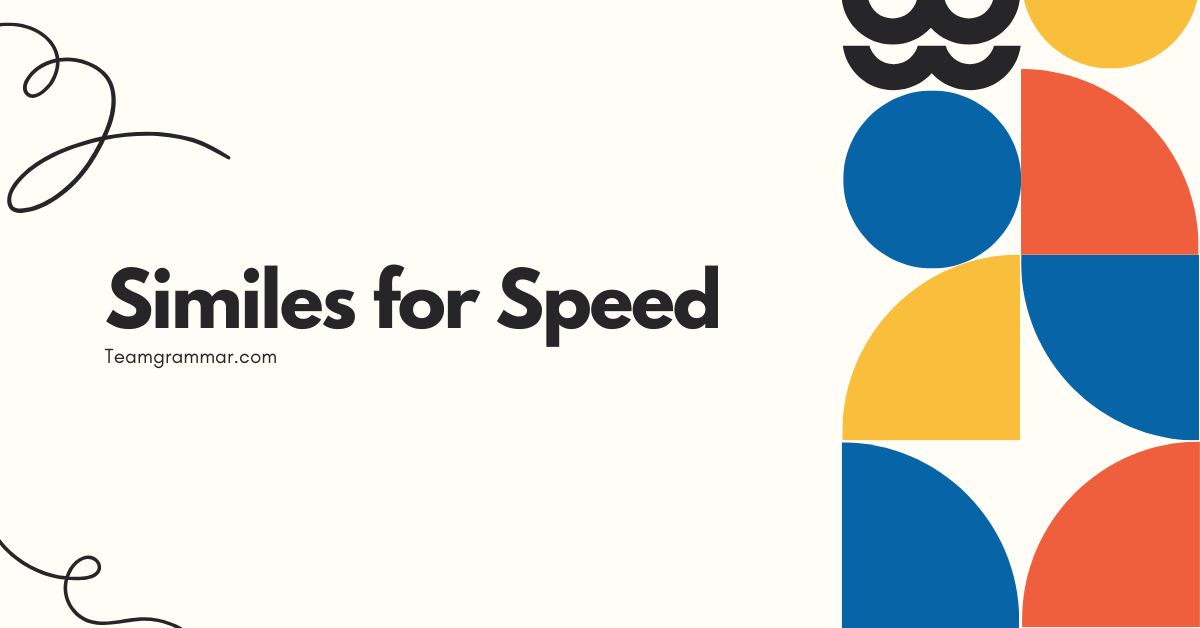31 Similes for Speed: Mastering Comparisons in English Grammar
Understanding similes is crucial for enriching your descriptive language and adding vividness to your writing and speech. Similes, a fundamental element of figurative language, allow us to draw comparisons between dissimilar things using words like “like” or “as.” This article delves specifically into similes that describe speed, enhancing your ability to depict swiftness and agility.
Whether you are a student, writer, or English language learner, mastering these similes will significantly improve your expressive capabilities and comprehension of nuanced language.
This guide provides a comprehensive exploration of similes related to speed, exploring their structure, types, and usage. Through numerous examples, practical exercises, and detailed explanations, you will gain a solid understanding of how to effectively use similes to convey the concept of speed.
By the end of this article, you will be well-equipped to use similes creatively and accurately, making your communication more engaging and impactful.
Table of Contents
- Definition of Similes
- Structural Breakdown of Similes
- Types of Speed Similes
- Examples of Speed Similes
- Usage Rules for Similes
- Common Mistakes with Similes
- Practice Exercises
- Advanced Topics in Similes
- Frequently Asked Questions
- Conclusion
Definition of Similes
Asimileis a figure of speech that compares two unlike things using the words “like” or “as.” Its primary function is to create a vivid image or enhance understanding by drawing a parallel between something familiar and something less known. Similes are a powerful tool in both writing and speech, allowing for more descriptive and engaging communication.
They are a subset of figurative language, which also includes metaphors, personification, and hyperbole.
The purpose of a simile is not just to state a similarity but to illuminate a specific quality or characteristic. By using similes, writers and speakers can add depth and color to their descriptions, making their message more memorable and impactful.
Similes are commonly found in literature, poetry, everyday conversation, and advertising.
Similes can be used in various contexts, from describing physical attributes to conveying emotions or abstract ideas. The effectiveness of a simile depends on the clarity and relevance of the comparison.
A well-crafted simile can transform a mundane statement into a captivating and insightful observation.
Structural Breakdown of Similes
The basic structure of a simile consists of three main components: thesubjectbeing described, thelinking word(either “like” or “as”), and theobjectof comparison. Understanding this structure is essential for creating and interpreting similes effectively.
The subject is the entity whose characteristic is being highlighted. The linking word establishes the comparison.
The object of comparison is what the subject is being likened to.
For example, in the simile “He ran like the wind,” “he” is the subject, “ran” describes the action, “like” is the linking word, and “the wind” is the object of comparison. This structure clearly indicates that the subject’s speed is being compared to the speed of the wind.
The order of these components can sometimes be varied for stylistic effect, but the core elements remain the same. For instance, one could say, “Like the wind, he ran,” while maintaining the same meaning.
The key is to ensure that the comparison is clear and logical.
Here is a breakdown of the structural elements:
- Subject: The person, place, thing, or idea being described.
- Action: The verb describing the subject’s activity.
- Linking Word: Typically “like” or “as,” connecting the subject to the object of comparison.
- Object of Comparison: The person, place, thing, or idea to which the subject is being compared.
Types of Speed Similes
Similes describing speed can be categorized based on the objects or concepts used for comparison. These categories help to create different nuances and levels of intensity in conveying swiftness.
Here are some common types of speed similes:
Animal-Based Similes
These similes use the speed of animals known for their quickness to describe the subject’s speed. Examples include: as fast as a cheetah, like a hare, as quick as a fox.
Nature-Based Similes
These similes draw comparisons to natural phenomena that exhibit speed, such as wind, lightning, or rivers. Examples include: like the wind, as swift as lightning, as fast as a flowing river.
Machine-Based Similes
These similes use the speed of machines or vehicles to illustrate rapid movement. Examples include: like a race car, as fast as a rocket, as quick as a bullet.
Abstract Similes
These similes use abstract concepts or ideas to convey speed. Examples include: as fast as thought, like a fleeting moment, as quick as a flash.
Exaggerated Similes
These similes use hyperbole to emphasize extreme speed. Examples include: faster than the speed of light, like a bat out of hell, quicker than greased lightning.
Examples of Speed Similes
Below are examples of similes for speed, categorized for clarity. Each category provides a variety of options to enhance your descriptive language.
Animal-Based Speed Similes
This table showcases various animal-based similes, each capturing different aspects of speed and agility.
| Simile | Explanation |
|---|---|
| As fast as a cheetah | Cheetahs are known for their incredible sprinting speed, making this simile ideal for describing bursts of extreme speed. |
| Like a hare | Hares are quick and nimble, often used to describe someone who is fast and agile. |
| As quick as a fox | Foxes are known for their cunning and speed, suitable for describing someone who is both fast and clever. |
| Like a startled gazelle | Gazelles are incredibly fast and agile, especially when evading predators. |
| As swift as a falcon | Falcons are known for their incredible diving speed, making this simile ideal for describing rapid descents. |
| Like a greyhound | Greyhounds are bred for racing and are renowned for their speed and agility. |
| As fast as a racehorse | Racehorses are bred for speed, making this simile perfect for describing sustained high-speed movement. |
| Like a darting hummingbird | Hummingbirds are known for their rapid and erratic movements, suitable for describing quick, unpredictable motions. |
| As speedy as a roadrunner | Roadrunners are known for their quickness and agility, perfect for describing someone who moves quickly and efficiently. |
| Like a scurrying squirrel | Squirrels are known for their agility and speed in navigating trees and the ground, useful for describing quick, darting movements. |
| As nimble as a mountain goat | Mountain goats are agile and quick-footed, ideal for describing someone who moves quickly and gracefully in difficult terrain. |
| Like a leaping frog | Frogs are known for their powerful leaps, suitable for describing quick, jumping movements. |
| As quick as a snake striking | Snakes are known for their lightning-fast strikes, perfect for describing sudden and rapid movements. |
| Like a spider scuttling across the floor | Spiders are known for their quick, scurrying movements, ideal for describing rapid, ground-level movement. |
| As fast as a swallow diving | Swallows are known for their aerial acrobatics and speed, suitable for describing rapid, diving movements. |
| Like a dragonfly in flight | Dragonflies are known for their agile and rapid flight, perfect for describing quick, erratic movements in the air. |
| As swift as a salmon swimming upstream | Salmon are known for their powerful and swift swimming, suitable for describing determined and rapid movement against a current. |
| Like a herd of wild horses | Wild horses are known for their speed and unbridled energy, perfect for describing a group moving quickly and powerfully. |
| As quick as a mongoose | Mongooses are known for their speed and agility, often used to describe someone who is fast and elusive. |
| Like a cheetah on the hunt | Cheetahs on the hunt are incredibly focused and fast, making this simile ideal for describing focused, high-speed pursuit. |
| As fast as a peregrine falcon diving | Peregrine falcons are the fastest animals on earth when diving, making this simile ideal for describing extremely rapid descents. |
| Like a kangaroo hopping across the outback | Kangaroos are known for their powerful and rapid hopping, suitable for describing quick, bounding movements. |
| As swift as a dolphin swimming through the ocean | Dolphins are known for their graceful and rapid swimming, perfect for describing fluid and fast movement in water. |
| Like a racehorse bolting from the gate | Racehorses bolting from the gate are incredibly fast and powerful, making this simile ideal for describing sudden bursts of speed. |
| As quick as a cat pouncing on its prey | Cats are known for their swift and precise pouncing, suitable for describing rapid and accurate movements. |
Nature-Based Speed Similes
This table explores similes that use natural elements to describe speed, providing vivid imagery and diverse comparisons.
| Simile | Explanation |
|---|---|
| Like the wind | The wind is often associated with swiftness and freedom, making this a common simile for speed. |
| As swift as lightning | Lightning is incredibly fast and sudden, perfect for describing instantaneous speed. |
| As fast as a flowing river | A flowing river conveys a sense of continuous and rapid movement. |
| Like a falling star | Falling stars are quick and fleeting, making this simile suitable for describing brief bursts of speed. |
| As quick as a wildfire spreading | Wildfires spread rapidly, making this simile ideal for describing something that moves quickly and uncontrollably. |
| Like a rolling thunder | Rolling thunder conveys a sense of powerful and rapid movement across the sky. |
| As fast as a tsunami approaching | Tsunamis move with incredible speed and force, suitable for describing overwhelming speed. |
| Like a landslide | Landslides are sudden and rapid, making this simile perfect for describing quick and destructive movements. |
| As swift as a blizzard | Blizzards move quickly and powerfully, suitable for describing fast and overwhelming conditions. |
| Like a hurricane’s winds | Hurricane winds are incredibly strong and fast, ideal for describing powerful and rapid movement. |
| As fast as a shooting star across the night sky | Shooting stars are quick flashes of light, perfect for describing brief and rapid appearances. |
| Like a wave crashing on the shore | Crashing waves are powerful and fast, making this simile suitable for describing dynamic and rapid impacts. |
| As quick as frost forming on glass | Frost forms rapidly, making this simile ideal for describing something that happens almost instantly. |
| Like a dust devil swirling across the desert | Dust devils are quick and swirling, suitable for describing rapid and erratic movements. |
| As swift as a cloud moving across the sky | Clouds can move quickly, especially during storms, making this simile perfect for describing steady and rapid movement. |
| Like a geyser erupting | Geysers erupt with sudden and powerful force, ideal for describing explosive and rapid bursts. |
| As fast as a river rushing through a canyon | Rivers rushing through canyons are fast and powerful, suitable for describing rapid and forceful movement. |
| Like a tornado tearing through a field | Tornados are destructive and fast, making this simile ideal for describing rapid and chaotic movement. |
| As quick as a sunrise | Sunrises happen relatively quickly, making this simile perfect for describing the rapid appearance of light. |
| Like a meteor streaking through the atmosphere | Meteors are incredibly fast and bright, suitable for describing rapid and dramatic appearances. |
| As swift as a glacier sliding downhill | Glaciers, though massive, can slide downhill with surprising speed, perfect for describing steady and powerful movement. |
| Like a snow avalanche cascading down a mountain | Snow avalanches are fast and overwhelming, making this simile ideal for describing rapid and destructive movements. |
| As fast as desert sands shifting in the wind | Desert sands can shift quickly in the wind, suitable for describing rapid and dynamic changes. |
| Like a tidal wave surging inland | Tidal waves are fast and powerful, perfect for describing rapid and forceful movements of water. |
| As quick as fog rolling in | Fog can roll in rapidly, making this simile ideal for describing the swift appearance of obscurity. |
Machine-Based Speed Similes
This table provides similes using machines to describe speed, offering comparisons to modern technology and transportation.
| Simile | Explanation |
|---|---|
| Like a race car | Race cars are designed for maximum speed, making this simile ideal for describing high-speed movement. |
| As fast as a rocket | Rockets are incredibly fast, perfect for describing extreme speed and acceleration. |
| As quick as a bullet | Bullets are known for their speed and impact, suitable for describing rapid and forceful movement. |
| Like a jet plane taking off | Jet planes accelerate rapidly during takeoff, making this simile ideal for describing quick acceleration. |
| As fast as a speeding train | Speeding trains convey a sense of continuous and rapid movement along a track. |
| Like a motorcycle zooming down the highway | Motorcycles are fast and agile, suitable for describing rapid and dynamic movement on roads. |
| As quick as a drone flying overhead | Drones are fast and maneuverable, making this simile perfect for describing rapid aerial movement. |
| Like a speedboat skimming across the water | Speedboats are designed for fast and smooth movement on water, ideal for describing rapid aquatic movement. |
| As fast as a fighter jet breaking the sound barrier | Fighter jets breaking the sound barrier are incredibly fast, suitable for describing extreme and groundbreaking speed. |
| Like a high-speed elevator ascending | High-speed elevators are designed for rapid vertical movement, making this simile perfect for describing quick ascents. |
| As quick as a robot moving on an assembly line | Robots on assembly lines are precise and fast, ideal for describing efficient and rapid movements. |
| Like a Formula One car on the racetrack | Formula One cars are known for their incredible speed and agility, suitable for describing high-performance movement. |
| As fast as a satellite orbiting the Earth | Satellites move at incredible speeds to maintain orbit, making this simile perfect for describing rapid and continuous movement. |
| Like a maglev train gliding on the tracks | Maglev trains are known for their smooth and rapid gliding, ideal for describing seamless and fast travel. |
| As quick as a conveyor belt moving products | Conveyor belts are designed for efficient and rapid movement of goods, suitable for describing continuous and fast processes. |
| Like a hyperloop pod traveling through a tube | Hyperloop pods are designed for ultra-high-speed travel, making this simile perfect for describing futuristic and rapid transit. |
| As fast as a computer processing data | Computers can process data incredibly quickly, making this simile ideal for describing rapid information processing. |
| Like a 3D printer creating a model | 3D printers work with impressive speed and precision, suitable for describing rapid and detailed construction. |
| As quick as an automated machine packaging items | Automated machines are efficient and fast, making this simile perfect for describing rapid and automated processes. |
| Like a Tesla accelerating from 0 to 60 mph | Teslas are known for their rapid acceleration, ideal for describing quick and powerful starts. |
| As fast as a production line churning out products | Production lines are designed for high-speed manufacturing, making this simile ideal for describing rapid and continuous output. |
| Like a drone delivering a package | Drones are fast and efficient at delivering packages, suitable for describing quick and targeted deliveries. |
| As quick as a robotic arm assembling parts | Robotic arms are precise and fast, making this simile perfect for describing rapid and accurate assembly. |
| Like a submarine cruising underwater | Submarines can move quickly underwater, ideal for describing stealthy and rapid aquatic movement. |
| As fast as a supercomputer running simulations | Supercomputers are known for their incredible processing speed, suitable for describing rapid and complex calculations. |
Usage Rules for Similes
Using similes effectively requires adherence to certain rules to ensure clarity and impact. Here are some key guidelines:
- Clarity: The comparison should be clear and easily understood by the audience. Avoid obscure or overly complex comparisons.
- Relevance: The object of comparison should share a relevant characteristic with the subject. The similarity should be meaningful and not arbitrary.
- Originality: While common similes can be effective, strive for originality to make your writing more engaging and memorable.
- Context: Consider the context in which the simile is used. The simile should be appropriate for the tone and style of the writing or speech.
- Avoid Clichés: Steer clear of overused similes that have lost their impact. These clichés can make your writing sound unoriginal and stale.
An effective simile enhances the reader’s understanding and appreciation of the subject. A poorly chosen simile can confuse or distract the reader.
Common Mistakes with Similes
Even experienced writers sometimes make mistakes when using similes. Here are some common errors to avoid:
| Incorrect | Correct | Explanation |
|---|---|---|
| He ran like a house. | He ran like the wind. | The comparison must be logical. Houses do not run, but the wind is known for its speed. |
| She was as fast as slow. | She was as fast as a cheetah. | The comparison should highlight a positive attribute. “Slow” negates the intended meaning. |
| He moved like he moved. | He moved like a blur. | The simile should offer a new perspective or insight. The original sentence is redundant. |
| The car was fast like a turtle. | The car was fast like a rocket. | Avoid using comparisons that contradict the intended meaning. Turtles are not fast. |
| She sings as good as an angel. | She sings as well as an angel. | Use proper grammar. “Well” is the correct adverb to modify the verb “sings.” |
| He jumped like a jumping person. | He jumped like a frog. | The simile should provide a more vivid or descriptive comparison than a literal statement. |
| The runner was as fast as always. | The runner was as fast as lightning. | The comparison should introduce a new element of description, not just restate the obvious. |
| The car accelerated like accelerating. | The car accelerated like a rocket taking off. | Avoid using the same verb in the comparison. The simile should add a fresh perspective. |
| She was as beautiful as beautiful. | She was as beautiful as a summer’s day. | The simile should provide a more descriptive and evocative comparison. |
| He worked like he worked hard. | He worked like a beaver. | The simile should offer a recognizable and meaningful comparison. |
Practice Exercises
Test your understanding of similes with these exercises. Fill in the blanks with appropriate similes to complete the sentences.
Exercise 1: Fill in the Blanks
Complete the following sentences with appropriate similes describing speed.
| Question | Answer |
|---|---|
| 1. The car sped down the highway, going __________. | 1. The car sped down the highway, going like a race car. |
| 2. The runner sprinted across the finish line, moving __________. | 2. The runner sprinted across the finish line, moving as fast as a cheetah. |
| 3. The news spread through the town, traveling __________. | 3. The news spread through the town, traveling like wildfire. |
| 4. The child ran to greet his mother, moving __________. | 4. The child ran to greet his mother, moving like a hare. |
| 5. The bird swooped down from the sky, descending __________. | 5. The bird swooped down from the sky, descending as swift as a falcon. |
| 6. The information was processed by the computer __________. | 6. The information was processed by the computer as fast as a supercomputer. |
| 7. The train moved along the tracks, traveling __________. | 7. The train moved along the tracks, traveling like a speeding train. |
| 8. The rocket launched into space, accelerating __________. | 8. The rocket launched into space, accelerating as fast as a rocket. |
| 9. The ball flew off the bat, shooting __________. | 9. The ball flew off the bat, shooting like a bullet. |
| 10. The motorcycle zipped through traffic, weaving __________. | 10. The motorcycle zipped through traffic, weaving like a dragonfly in flight. |
Exercise 2: Identify the Simile
Identify the simile in each sentence and explain what is being compared.
| Question | Answer |
|---|---|
| 1. He ran as fast as a speeding train to catch the bus. | 1. Simile: as fast as a speeding train. Comparison: The man’s running speed is compared to the speed of a speeding train. |
| 2. The cheetah darted across the savanna like a flash of lightning. | 2. Simile: like a flash of lightning. Comparison: The cheetah’s speed is compared to the suddenness and quickness of lightning. |
| 3. News of the event spread as quickly as a wildfire through the community. | 3. Simile: as quickly as a wildfire. Comparison: The speed of the news spreading is compared to the rapid spread of a wildfire. |
| 4. The race car zoomed around the track like a rocket. | 4. Simile: like a rocket. Comparison: The race car’s speed is compared to the speed of a rocket. |
| 5. The athlete moved as swiftly as a falcon diving for its prey. | 5. Simile: as swiftly as a falcon diving. Comparison: The athlete’s swiftness is compared to the rapid dive of a falcon. |
| 6. The new computer processed the data as fast as a supercomputer. | 6. Simile: as fast as a supercomputer. Comparison: The computer’s processing speed is compared to the speed of a supercomputer. |
| 7. The rumor spread through the office like the wind. | 7. Simile: like the wind. Comparison: The speed of the rumor spreading is compared to the speed of the wind. |
| 8. The baseball flew off the bat as quick as a bullet. | 8. Simile: as quick as a bullet. Comparison: The speed of the baseball is compared to the speed of a bullet. |
| 9. The motorcycle raced down the highway like a jet plane taking off. | 9. Simile: like a jet plane taking off. Comparison: The motorcycle’s acceleration is compared to the rapid takeoff of a jet plane. |
| 10. The sprinter burst from the starting blocks as fast as lightning. | 10. Simile: as fast as lightning. Comparison: The sprinter’s initial speed is compared to the speed of lightning. |
Exercise 3: Create Your Own Similes
Create your own similes to describe the following scenarios, focusing on speed.
| Scenario | Your Simile |
|---|---|
| 1. A skateboarder racing down a hill | 1. Like a bullet train speeding downhill. |
| 2. A child running to catch an ice cream truck | 2. As fast as a hummingbird darting for nectar. |
| 3. A hockey puck flying across the ice | 3. Like a shooting star streaking across the sky. |
| 4. A racehorse sprinting to the finish line | 4. As swift as a tornado tearing through a plain. |
| 5. A cyclist speeding down a mountain | 5. Like a peregrine falcon diving from the sky. |
| 6. A cheetah chasing its prey | 6. As fast as a Formula One car on a racetrack. |
| 7. A cloud moving across the sky during a storm | 7. Like a speedboat skimming across the water. |
| 8. A robot working on an assembly line | 8. As quick as an automated machine packaging items. |
| 9. An elevator ascending to the top floor of a skyscraper | 9. Like a rocket launching into space. |
| 10. A computer processing a complex algorithm | 10. As fast as a supercomputer running simulations. |
Advanced Topics in Similes
For advanced learners, exploring more nuanced aspects of similes can further enhance their understanding and usage:
- Extended Similes: These are similes that are developed over several sentences or even paragraphs, providing a more detailed and elaborate comparison.
- Implied Similes: These are similes where the linking word (“like” or “as”) is omitted, creating a more subtle comparison.
- Juxtaposition of Similes: Using multiple similes in close proximity can create a richer and more complex description.
- Similes in Different Genres: The use of similes can vary depending on the genre, with poetry often employing more figurative and evocative similes compared to technical writing.
Mastering these advanced techniques can significantly elevate your writing and communication skills.
Frequently Asked Questions
Here are some frequently asked questions about similes:
- What is the difference between a simile and a metaphor?
A simile compares two things using “like” or “as,” while a metaphor directly equates two things without using these words. For example, “He is like a lion” (simile) vs. “He is a lion” (metaphor).
- Why are similes important in writing?
Similes add vividness, clarity, and depth to writing by creating memorable comparisons. They help readers visualize and understand concepts more effectively.
- How can I avoid using clichés in my similes?
Strive for originality by thinking of unique and unexpected comparisons. Consider the specific qualities you want to highlight and brainstorm objects or concepts that share those qualities in a less obvious way.
- Can similes be used in formal writing?
Yes, but use them sparingly and appropriately. Ensure that the similes are clear, relevant, and contribute to the overall message without being overly informal or distracting.
- What makes a simile effective?
An effective simile is clear, relevant, and provides a fresh perspective or insight. It should enhance the reader’s understanding and appreciation of the subject.
- Are there any specific contexts where similes are particularly useful?
Similes are particularly useful in descriptive writing, poetry, and persuasive writing. They can also be effective in explaining complex concepts or making abstract ideas more concrete.
- How do I choose the right object of comparison for a simile?
Choose an object of comparison that shares a relevant characteristic with the subject and is easily understood by your audience. Consider the tone and context of your writing to ensure the simile is appropriate.
- What is an extended simile, and how is it used?
An extended simile is a simile that is developed over several sentences or paragraphs. It provides a more detailed and elaborate comparison, allowing for a deeper exploration of the similarities between the subject and the object of comparison. It is used to create a more vivid and lasting impression on the reader.
- Can a simile be too complex or confusing?
Yes, a simile can be too complex if the comparison is obscure or difficult for the reader to understand. It is important to ensure that the simile is clear and relevant to the subject being described.
- How can I improve my ability to create effective similes?
Practice using similes in your writing and pay attention to the similes used by other writers. Read widely and observe how different authors use similes to create different effects. Experiment with different comparisons and ask for feedback on your similes.
Conclusion
Mastering similes is an essential skill for anyone looking to enhance their descriptive language and communication abilities. By understanding the structure, types, and usage rules of similes, you can effectively convey vivid images and create more engaging content.
This article has provided a comprehensive guide to similes for speed, offering numerous examples, practice exercises, and explanations to solidify your knowledge.
Remember, the key to using similes effectively is clarity, relevance, and originality. By avoiding clichés and striving for unique comparisons, you can make your writing more memorable and impactful.
Continue to practice and experiment with similes in your writing and speech to further refine your skills. With consistent effort, you will become proficient in using similes to add depth and color to your communication.
As a final tip, always consider your audience and the context in which you are using similes. Tailor your comparisons to ensure they are easily understood and relevant to the topic at hand.
With these guidelines in mind, you are well-equipped to master the art of using similes and elevate your communication to new heights.







